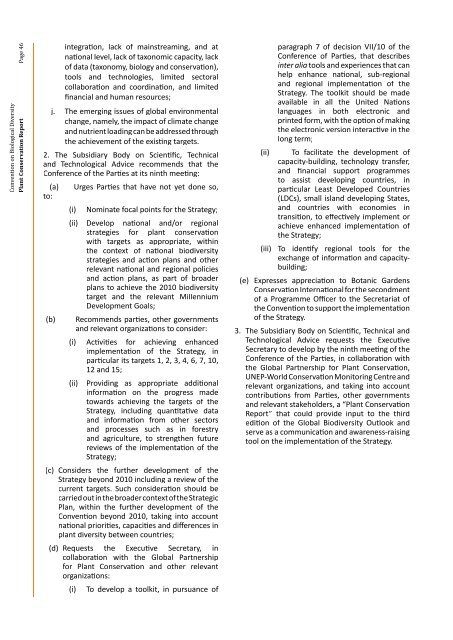from the global partnership for plant conservation
from the global partnership for plant conservation
from the global partnership for plant conservation
You also want an ePaper? Increase the reach of your titles
YUMPU automatically turns print PDFs into web optimized ePapers that Google loves.
Convention on Biological DiversityPlant Conservation Report Page 46integration, lack of mainstreaming, and atnational level, lack of taxonomic capacity, lackof data (taxonomy, biology and <strong>conservation</strong>),tools and technologies, limited sectoralcollaboration and coordination, and limitedfinancial and human resources;j. The emerging issues of <strong>global</strong> environmentalchange, namely, <strong>the</strong> impact of climate changeand nutrient loading can be addressed through<strong>the</strong> achievement of <strong>the</strong> existing targets.2. The Subsidiary Body on Scientific, Technicaland Technological Advice recommends that <strong>the</strong>Conference of <strong>the</strong> Parties at its ninth meeting:(a)to:(b)(i)Urges Parties that have not yet done so,Nominate focal points <strong>for</strong> <strong>the</strong> Strategy;(ii) Develop national and/or regionalstrategies <strong>for</strong> <strong>plant</strong> <strong>conservation</strong>with targets as appropriate, within<strong>the</strong> context of national biodiversitystrategies and action plans and o<strong>the</strong>rrelevant national and regional policiesand action plans, as part of broaderplans to achieve <strong>the</strong> 2010 biodiversitytarget and <strong>the</strong> relevant MillenniumDevelopment Goals;Recommends parties, o<strong>the</strong>r governmentsand relevant organizations to consider:(i) Activities <strong>for</strong> achieving enhancedimplementation of <strong>the</strong> Strategy, inparticular its targets 1, 2, 3, 4, 6, 7, 10,12 and 15;(ii)Providing as appropriate additionalin<strong>for</strong>mation on <strong>the</strong> progress madetowards achieving <strong>the</strong> targets of <strong>the</strong>Strategy, including quantitative dataand in<strong>for</strong>mation <strong>from</strong> o<strong>the</strong>r sectorsand processes such as in <strong>for</strong>estryand agriculture, to streng<strong>the</strong>n futurereviews of <strong>the</strong> implementation of <strong>the</strong>Strategy;(c) Considers <strong>the</strong> fur<strong>the</strong>r development of <strong>the</strong>Strategy beyond 2010 including a review of <strong>the</strong>current targets. Such consideration should becarried out in <strong>the</strong> broader context of <strong>the</strong> StrategicPlan, within <strong>the</strong> fur<strong>the</strong>r development of <strong>the</strong>Convention beyond 2010, taking into accountnational priorities, capacities and differences in<strong>plant</strong> diversity between countries;(d) Requests <strong>the</strong> Executive Secretary, incollaboration with <strong>the</strong> Global Partnership<strong>for</strong> Plant Conservation and o<strong>the</strong>r relevantorganizations:(i)To develop a toolkit, in pursuance of(ii)paragraph 7 of decision VII/10 of <strong>the</strong>Conference of Parties, that describesinter alia tools and experiences that canhelp enhance national, sub-regionaland regional implementation of <strong>the</strong>Strategy. The toolkit should be madeavailable in all <strong>the</strong> United Nationslanguages in both electronic andprinted <strong>for</strong>m, with <strong>the</strong> option of making<strong>the</strong> electronic version interactive in <strong>the</strong>long term;To facilitate <strong>the</strong> development ofcapacity-building, technology transfer,and financial support programmesto assist developing countries, inparticular Least Developed Countries(LDCs), small island developing States,and countries with economies intransition, to effectively implement orachieve enhanced implementation of<strong>the</strong> Strategy;(iii) To identify regional tools <strong>for</strong> <strong>the</strong>exchange of in<strong>for</strong>mation and capacitybuilding;(e) Expresses appreciation to Botanic GardensConservation International <strong>for</strong> <strong>the</strong> secondmentof a Programme Officer to <strong>the</strong> Secretariat of<strong>the</strong> Convention to support <strong>the</strong> implementationof <strong>the</strong> Strategy.3. The Subsidiary Body on Scientific, Technical andTechnological Advice requests <strong>the</strong> ExecutiveSecretary to develop by <strong>the</strong> ninth meeting of <strong>the</strong>Conference of <strong>the</strong> Parties, in collaboration with<strong>the</strong> Global Partnership <strong>for</strong> Plant Conservation,UNEP-World Conservation Monitoring Centre andrelevant organizations, and taking into accountcontributions <strong>from</strong> Parties, o<strong>the</strong>r governmentsand relevant stakeholders, a “Plant ConservationReport” that could provide input to <strong>the</strong> thirdedition of <strong>the</strong> Global Biodiversity Outlook andserve as a communication and awareness-raisingtool on <strong>the</strong> implementation of <strong>the</strong> Strategy.
















